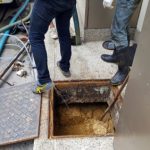What to Expect from a Grease Trap Inspection

What is a Grease Trap Inspection?
A grease trap inspection is a thorough examination of your grease trap to ensure that it is working properly and not causing any issues for your plumbing system. During an inspection, a trained professional will check the tank for any signs of buildup or blockages, clean out any accumulated grease and debris, and make sure that all components of the trap are functioning correctly. The frequency of these inspections will depend on the size of your grease trap and the volume of grease being produced in your kitchen, but most experts recommend having your trap inspected at least once every three months.
Why are Grease Trap Inspections Important?
Regular grease trap inspections are crucial for maintaining the health and efficiency of your plumbing system. When grease and other food particles are washed down the drain, they can build up inside your pipes and cause blockages that can lead to backups and overflows. A grease trap helps to prevent this by catching the grease before it can enter the sewer system, but if the trap becomes too full or malfunctions, the grease can still make its way into your pipes.
In addition to preventing clogs and backups, regular inspections can also help you save money in the long run. By catching any issues early on, you can address them before they become major problems that require costly repairs or replacements. Inspections can also help you identify any areas where you may be producing excess grease and make changes to your kitchen practices to reduce this waste.
What to Expect During a Grease Trap Inspection
During a grease trap inspection, the technician will first visually inspect the exterior of the trap to check for any leaks or damage. They will then open the lid and examine the inside of the trap for any signs of buildup or blockages. If the trap is full, they will remove the grease and debris using specialized tools and equipment.
The technician will also check the flow of water through the trap to make sure that it is functioning properly. They may also measure the depth of the grease in the trap to determine how quickly it is accumulating and whether the trap needs to be pumped. Finally, the technician will inspect the seals and gaskets on the trap to make sure that they are intact and not allowing any grease to leak out.
After the inspection is complete, the technician will provide you with a detailed report of their findings and any recommendations for maintenance or repairs. They may also schedule a time for the next inspection based on the volume of grease being produced in your kitchen.
How to Prepare for a Grease Trap Inspection
To ensure that your grease trap inspection goes smoothly, there are a few steps you can take to prepare. First, make sure that the area around the trap is clear and accessible so that the technician can easily open and inspect the trap. Remove any objects or debris that may be obstructing the lid or blocking access to the trap.
You should also keep detailed records of when your last inspection was and any maintenance that has been performed on the trap since then. This information can be helpful for the technician in determining the frequency of inspections needed and identifying any recurring issues that may need to be addressed.
In addition, it is important to follow proper grease disposal practices in your kitchen to prevent excessive buildup in your trap. Make sure that all employees are aware of the proper way to dispose of grease and food waste and provide training if necessary. By taking these steps, you can help ensure that your grease trap is working effectively and prevent costly plumbing problems in the future.
Summary
Regular grease trap inspections are essential for maintaining the health and efficiency of your plumbing system. By staying on top of this important maintenance task, you can prevent clogs, backups, and other issues that can disrupt your business operations and cost you money. If you own a restaurant or commercial kitchen, make sure to schedule regular inspections for your grease trap and follow proper grease disposal practices to keep your plumbing system running smoothly. Your wallet and your pipes will thank you for it!
Need Grease Trap Services in New Orleans, LA?
Hiring a professional cooking oil disposal service is a wise choice for individuals and businesses alike. These services offer efficient and convenient collection, environmentally responsible disposal, and compliance with regulations. Additionally, they contribute to recycling efforts and help reduce maintenance costs. By entrusting your used cooking oil to a professional service, you are not only doing your part in protecting the environment but also saving yourself time, effort, and potential headaches associated with improper disposal. And if you feel like you’re in need of a professional cooking oil disposal service, don’t hesitate to reach out and contact us today!
Categorised in: Grease Trap Cleaning, Grease Trap Service
